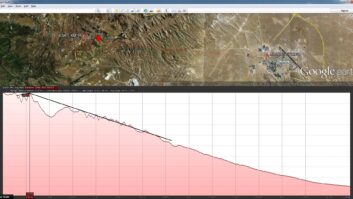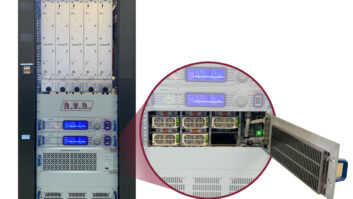(click thumbnail)An A/D converter may be needed for HD-R conversion. Photo by Cris AlexanderFor a lot of stations, STL and AES issues are major considerations in the HD Radio conversion process. This is particularly true for AM stations, many of which may be operating using analog monaural STL systems. For HD Radio, stations will need the best, most transparent STL conveyance possible.
Generally speaking, digital is better than analog for a number of reasons, but a good analog STL with a clear path, plenty of fade margin and an excellent signal-to-noise ratio can do the job for an HD Radio station. If a station has analog studios, for example, and the analog STL is otherwise transparent, there is no compelling reason to immediately convert to a digital STL system. The A/D conversion can be done at the transmitter site with equally good results as converting at the studio and using a digital STL.
That being said and assuming a clear, interference-free path, a digital STL will get you a better, more noise-free signal to the transmitter site. The output will be in the digital domain, which is where you need to be eventually anyway. If your studios are already digital, the best course of action is to stay in the digital domain all the way to the transmitter site if possible.
Avoid repeated conversions
Repeated conversions between analog and digital and even sample rate conversions are to be avoided if possible. Each conversion degrades the audio quality by a small amount, and remember that the HDC coder is fairly aggressive, especially the low-rate AM coder. Each A/D-D/A or sample rate conversion pass results in an audible degradation after a pass through the HDC AM coder.
The FM coder fares better, but with enough passes the degradation will be audible even at the higher rate of the FM coder. A word to the wise: standardize on a 48 kHz sample rate and leave it there all the way through the chain.
Multiple MPEG passes are also to be avoided at all costs. If your station uses a compressed digital STL, you might want to look for alternatives.
Higher data rates are better than lower ones. One of the worst-case situations results when an AM station takes a 128 kilobit-per-second MPEG network satellite feed, feeds it through an MPEG STL and through the HDC coder. The resulting demodulated HD Radio audio will be loaded with artifacts and sound like a bad Internet stream.
We have found that if it is impossible to avoid the MPEG pass in the STL, at least get the data rate up to 256 kbps or better. That 256 kbps floor should apply as an absolute minimum for all source material, including spots, promos and other material, much of which arrives at the producer’s inbox via e-mail these days.
We have found that apt-X seems to play fairly well with the HDC coder. G.722 and linear digital STLs also work well.
Once your station is up and running, it is important to pay attention to remote sources for compatibility. Some adjustments may be required.
Digital domain
You may well find that the POTS codec that your station has used for remote broadcasts for years sounds less than stellar after a trip through the HDC coder. An alternative may be needed.
Sooner or later, you’re going to have to get your audio into the digital domain. If you have digital studios, you’re set to go. The output of your mixer will be AES, hopefully 48 kHz AES.
If your studios are analog and you’re using a digital STL, you can convert ahead of the STL or in some cases, let the STL do it for you. Some have analog audio inputs and perform the A/D conversion internally.
If you’re analog all the way to the transmitter site, you have a couple of choices. The method preferred by most transmitter manufacturers is to provide an AES studio signal to the HD generator. You can generate such signal locally with any quality A/D converter.
We have found that some audio processors do a smoother job of A/D conversion than dedicated external converters. You may save yourself some money and produce better-sounding digital audio by letting your processor do the work. If you do this, you may have to depart from the transmitter/HD generator manufacturer’s recommended audio routing scheme, but from our experience, there is no penalty for doing this.
So, will your existing STL work when you convert to HD Radio? The answer is, “probably,” but you likely have some STL work to do to make the path optimal for HD Radio.
Radio World pays for your technical tips and stories. Inquire to [email protected].













